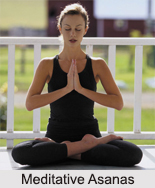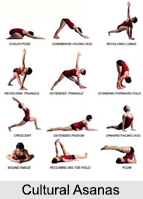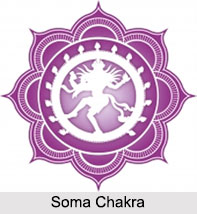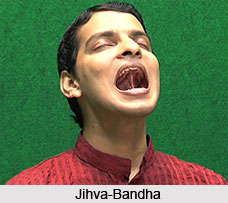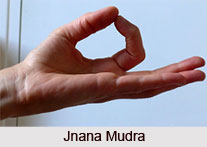 Jnana Mudra and Chin Mudra are the yogic "mudras", instruments or body gestures of the hand that prepare the mind for meditation and enhance the power and depth of concentration of the practitioner. Yoga experts put it that the hands have a stronger relationship to the mind than much of the rest of the body. If the hands are placed in a position of calm and stillness, the mind can mirror the same qualities. Thus, a mudra can be instrumental in preparing the mind for meditation and sustaining concentration all throughout the process.
Jnana Mudra and Chin Mudra are the yogic "mudras", instruments or body gestures of the hand that prepare the mind for meditation and enhance the power and depth of concentration of the practitioner. Yoga experts put it that the hands have a stronger relationship to the mind than much of the rest of the body. If the hands are placed in a position of calm and stillness, the mind can mirror the same qualities. Thus, a mudra can be instrumental in preparing the mind for meditation and sustaining concentration all throughout the process.
Jnana Mudra and Chin Mudra are among the most well known hand mudras, yogic gestures that represent the unified nature of human consciousness and knowledge. These mudras are the hand postures where the thumb and the forefinger touch and hold each other, with the other three fingers extending out. The forefinger represents the ego or the self, while the thumb is seen as consciousness or God. When they are placed together, there is a sense of the self connecting to the universe. Creating this bodily connection in the hands helps in establishing the same attitude and connection in the mind. When the remaining fingers point up to the heaven, the posture is referred to as the Jnana Mudra while the fingers pointing down to earth is called the Chin Mudra.
Jnana Mudra
The Jnana Mudra is also known as the "psychic gesture of knowledge", where the hands are placed on the knees in seated meditation with the palms facing up. This mudra gives a feeling of spaciousness and has a subtle uplifting effect on the body and the mind. The connection is made by the thumb and the index figure which creates a kind of circuit by connecting the terminus of certain "nadi" (body channel or stream through which the breath flows), thus re-circulating the body"s vital energy.
Steps for practising Jnana Mudra
The Jnana Mudra is done following the given pattern:
•Assume a comfortable meditation posture.
•Fold the index fingers of both hands so that they touch the inside root of their respective thumbs.
•Spread the other three fingers of each hand such that they are relaxed and slightly apart.
•Place the hands on the knees with the palm facing upwards and the three unbent fingers and thumb of each hand pointing to the skies.
•Relax the hands and arms.
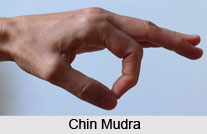 The tip of the thumb and the index finger touching each other is also the correct posture of Jnana Mudra.
The tip of the thumb and the index finger touching each other is also the correct posture of Jnana Mudra.
Chin Mudra
Chin Mudra, the psychic gesture of consciousness, is practised in either seated meditation or in Pranayama, such as the Ujjayi Pranayama. The hands rest on the knees or thighs, facing down. This gesture has a grounding effect on the mind. The middle, ring and little fingers represent the three intrinsic qualities of human nature (the three "Gunas"). The middle finger symbolises "sattva" (purity, wisdom and true understanding), the ring finger symbolises "rajas" (action, passion and movement) and the little finger "tamas" (inertia, lethargy and darkness). Classically, the yogi is meant to transcend these states, progressing from darkness into the light and from ignorance to wisdom.
Steps for practising Chin Mudra
The Chin Mudra is performed in the same manner as the Jnana Mudra, except that the palms of both hands face downwards, the hands and arms relaxed.
Benefits of Jnana Mudra and Chin Mudra
Jnana Mudra and Chin Mudra are simple but influential psycho-neural finger locks which make meditation "asanas" such as "padmasana", "siddhasana", "siddha yoni asana", "sukhasana", "vajrasana" and others, deep, complete and more powerful by redirecting the nervous impulses from the hands up to the body. The palms and fingers of the hands have many nerve root endings with constantly emitting energy, and when the finger touches the thumb, a circuit is produced which allows the energy that would normally dissipate into the environment, travel back into the body and up to the brain.
When the fingers and hands are placed on the knees, the knees are sensitised, creating another "pranic" (breath) circuit that maintains and redirects "prana" within the body. In addition, placing the hands on the knees stimulates a "nadi" which runs from the knees, up the inside of the thighs and into the perineum. This nadi is known as "gupta" or the hidden nadi. Sensitising this channel helps stimulate the energies at "mooladhara chakra".
The benefits of Jnana Mudra and Chin Mudra can be therefore summarised as hereunder:
•Creation of a "pranic" circuit, which maintains and redirects and maintains the flow of "Prana" (life force or vital breath) within the body.
•Improvement and increase in depth of concentration, during meditation and otherwise.
•Increasing energy and stamina.
•Promotion of better sleep patterns.
•Reduction of common ailments like lower back pain.
•Relieving stress and any unnecessary tension from the body and mind.
•Stimulation of the energies based at the Mooladhara Chakra.
